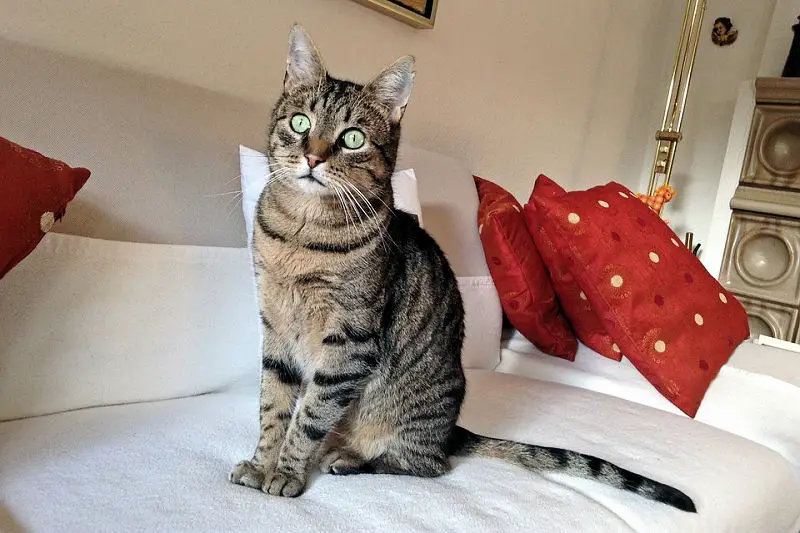Last month we did a post on a Day in the Life of a Cat Behaviorist with Clare Hemington from London. Today we zip back across the pond to San Francisco for a different purrspective and chat with Daniel “DQ” Quagliozzi who is the Behavior Consultant behind Go, Cat, Go! an in-home resource for cat behavior advice.

With over a decade of experience working for the San Francisco SPCA as a specialist in cat behavior, intake and adoption, Daniel is the “go to guy” in the San Francisco Bay Area for anyone experiencing a cat crisis. He brings a wealth of knowledge, experience and a compassionate manner to his clients, and is well respected for his practical, action-oriented approach to problem solving. DQ’s known within the inner feline-fan circles as the “Man with the Action Plan!”
In case you’re wondering if DQ is cat-centric…you decide for yourself! =^..^=

We wanted to know what all the fuzz was about so we asked DQ about his approach. His mantra:
Is your resident feline making you frantic? Solving your crisis is my mission. I can restore peace of mind to your home and help you rebuild your friendship with your feline friends. When your kitty is thinking outside the box, it’s time to call Go, Cat, Go!
He first shared with us his Cat Charter called: FIVE RULES FOR HUMANS LIVING IN CATLANDIA.
So what is this Catlandia Charter we asked?
[clickToTweet tweet=”Catlandia Charter: Five Rules for a Living in Harmony with Cats” quote=”Catlandia Charter: Five Rules for a Living in Harmony with Cats”]

DQ explains:
Humans and cats have been trying to peacefully coexist for centuries, and for the most part, we are doing ok … with a little room for improvement. Our relationship with cats has definitely changed over time, with technology allowing us to connect with the masses and disconnect from the very place our cats try their best to meet with us; the present moment, or as I like to call it: “The Meow”.
Modern convenience also allows humans to have very specific ideas about how they want their homes to look and feel. It enables a sense of urgency to how fast we like our conflicts to be resolved. Cats however … have not changed one bit. If anything, they may have become lazier from our influence and they have all the time in the world to do nothing.
We have basically evolved into beings that fit their whole lives into boxes. Sometimes, we invite cats to live inside and outside our boxes with us. Heck, we even expect them to use a box as a bathroom, regardless of how it looks, smells or where it is located. Basically, we set our own ground rules for living and expect our cat friends to adhere to the lines we draw around them. We come to understand that our feline guests have their own agenda pretty quickly. In fact, they’re not acting like guests at all. They’re treating our homes like their personal AirB&Pee!
Your home has a different name now … Welcome to Catlandia, which is basically any place that cats live! You invited cats to stay – now you have to obey! Resistance is futile. Surrender is inevitable.
Star Trek fans will appreciate The Borg reference. Cliché? Perhaps, but true when it comes to living with cats!
Quagliozzi goes on to explain his Cat Charter as Five (5) guidelines for peaceful coexistence in a world free of your own frustration.
Here they are:
1. CATS DON’T UNDERSTAND “PROPERTY”
So here’s the thing … cats don’t see a difference between your stuff and their stuff. They aren’t drawing lines between where they are “allowed” to go. We do that; expecting them to understand that jumping on a counter top or dinner table is unacceptable.
The problem is, cats go anywhere they please, because to them, everything in their territory belongs to them, including your stuff and sometimes …YOU. They expect it all.

Cats have a natural instinct to get off the ground, especially if it’s not rewarding on the floor. They want to be where the action is. That’s why cats choose to hang in places with high social significance, like couches, dressers and counter tops or anywhere they can get the best possible vantage points. If you haven’t provided alternatives like cat shelves, climbing structures or made it practically impossible to sit or stand in places that you can’t compromise, cats are going to take advantage of what the landscape provides. You’re going to have to give in a little to strike a balance and erase the lines.
Cats scratch furniture. True story! But … it doesn’t have to be that way! Give cats alternatives to your furniture and be observant of their preferences for location and material. Cats are going to scratch places that they consider important. That’s usually any scratch-able surface that you sit on too! If you’re having a hard time accepting their compliments, then make sure to provide your cats with places that they can call their own and scratch-friendly options that respect their preferences. The ultimate compliment is embracing their need for ownership.
2. CATS ARE DISOBEDIENT
Like fuzzy little punk rockers; cats have a way of pawing their noses at authority. They just can’t be told what to do and the harder you try to make them conform, the more they push back against your will to change them. That doesn’t mean that they can’t be influenced or trained. It just means that if it’s your idea to make them do something, it’s probably not going to happen the way you planned. They read your intentions like a psychic.

Cats are not motivated to please you the same way that dogs are. They have unspoken expectations and even a sense of entitlement to the resources that humans provide. That doesn’t mean that they don’t understand reward. It’s quite literally the one thing that a cat understands best! They just prefer to get those rewards on their own terms and not on your behalf. The trick is allowing them access to the rewards without stepping on their toes too much. If there are benefits to be had, you can bet a cat will be around to receive them.
Training a cat is easy to do, if you understand what motivates them and are willing to devote the time. For some cats, it might be food or treats that keep their eyes on the prize, while others prefer playtime or affection. You can clicker train cats to do all sorts of tricks and tasks, if they’re willing to work for food. Food might be the one thing you can actually control in this relationship, but don’t get cocky. Using food too much robs you of power and might ultimately backfire on you.
3. CATS CAN BE SELFISH
To say that cats are self-serving creatures would be a bit of an understatement. They mostly do what benefits them personally. When sharing living spaces with humans, cats learn quite quickly that there are very specific benefits to the partnership. We provide access to never ending buffets of food, along with all the bells and whistles (sometimes literally) to keep them happy in our homes. But is it ever enough? Probably not; the more benefit you provide, the more likely a cat is to be there waiting for it each day. I call this the “Double edged sword of cat companionship.”

Most cats don’t like to collaborate with other cats when it comes to playtime. When faced with one target in a group dynamic, some cats just take a seat and wait until it’s their turn, which may never come, because one cat is monopolizing the playing field. In a multi-cat home, it is essential that each cat have solo opportunities for interactive play. This helps to reduce tension, competition, anxiety and boredom. Keep it real and the benefits will balance out the rest.
Does it seem like some cats just don’t appreciate petting? Or are we just opting to pet them in the wrong places? Cats like to be stroked in self-serving places like their cheeks, flanks and shoulders. Respectfully petting these areas, allowing the cat to steer the experience, releases pheromones and solidifies the bond between guardian and friend on their terms. Don’t get ahead of yourself. Serve the cat first and you’ll be richly rewarded later.
4. CATS NEED CHOICES
Most cats have a pretty clear threshold for how much physical attention they want. It’s the human need for petting and physical affection that often supersedes and disregards a cat’s crystal clear warning signs to cease and desist.
Before reaching above or below to pet, hug, carry, snuggle, kiss, move or dress your cat, ask yourself, ”Did I ask permission first?” Giving your cat the opportunity to answer, “Yes” or “No” to a proposal, allows them the free will to make a choice. We already know they won’t obey us or do anything for our benefit, so why would petting be any different? Masters of the art of the deal, when given a choice, a cat will likely always say, “No”, if the benefits don’t outweigh the proposal.

In multi-cat homes, competition for shared resources, like feeding stations, toys, perches and litter boxes can be a huge trigger for tension, bullying and even inappropriate elimination outside of the box. It’s essential that each cat in the home have accommodations that match their individual preferences for privacy or party time.
Pay attention to your cat’s habits, particularly when it comes to litter box placement and design, it’s always better to think about the cat first! Spread out scratching posts, cat trees and climbing structures and be sure to have places to soak up individual and group cat scents, along with the places that harness your own.
5. CATS ARE NEVER WRONG
There’s never going to be a time when your cat thinks they did something wrong. Their actions are 100% justified, even when the result is negatively received. That’s why involving yourself in any form of punishment is a futile endeavor. Cats don’t follow directions or do things on your behalf, remember? So, unless your providing a benefit, getting yourself involved in the correction of their behavior will never get the point across.

Yes, I know, the pee incident happened on your pillow, and that is enough to anger anyone, but that doesn’t mean your personal reaction will have any impact on change. Shouting, scolding, or physically reprimanding your cat will only serve to complicate your relationship more. Remember, a cat is not motivated by spite or anger. That’s what WE do.. Don’t get angry! Get to work on your relationship. Your cat is telling you that something within our world of lines … does not line up.
Well there you have it. A Cat Charter to help us mere mortals co-exist more harmoniously with our feline masters!
We had a few questions for Daniel and he was more than gracious to entertain them. Keep reading =>
…cont./




All this sounds pretty sensible and realistic!